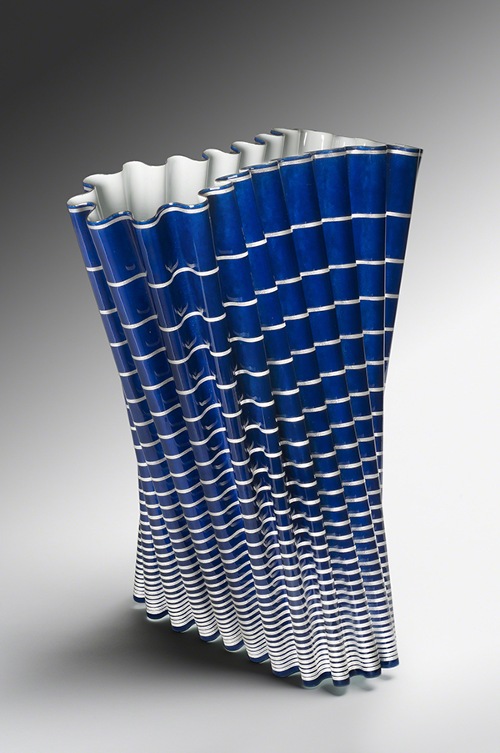Gem of the Month: Naoki Takeyama
If you are fascinated by the ancient art form of cloisonné enamel, then you will be even more excited to see the art of Naoki Takeyama. His enameled copper works are simply stunning!
 |
| Naoki Takeyama (born 1974, Japan), Yumegatari (Reverie), 2013. Enamel on copper with silver leaf decoration, 15 ½" x 9 ½" x 8 ⅞" (39.4 x 24.1 x 22.5 cm). Courtesy of the Philadelphia Museum of Art. © 2024 Naoki Takeyama. (PMA-8442) |
Pushing the boundaries of enameled metal to a wealth of new possibilities is the driving force behind Takeyama’s art. He first manipulates a copper sheet into shape by hand, riveting the body into a writhing, twisting, dynamic form. Takeyama often includes "pleats" in works such as Yumegatari (Reverie), one of the pieces the artist produces most often. Rather than enameling with the use of wires (cloisonné), he uses a small sieve and bamboo paddle to apply powder-based enamel glaze onto the body, which crystallizes after firing in an electric kiln. After it's dry, he applies another layer of glaze and fires it again. Repeating this process up to ten times results in variegated, brilliant hues of multiple layers of cobalt blue glaze that begin to merge like layers of paint. Takeyama applies the silver leaf last, fires the piece the kiln, then applies a transparent glaze to trap the metallic leaf in the body of the work.
The art of enamel on metal (shippō in Japanese) is thought to have been practiced in Japan at least since the 600s CE based on enameled metal found in mound tombs near the ancient capital of Nara. As early as the 700s CE, a government official was in charge of founding metals and painted glass decoration (i.e., enamel on metal), according to the civic manual known as the Taihō Code. Enameled wares declined in popularity until the 1600s, when a series of artists revived the traditional form of cloisonné. Cloisonné is the French word for the technique developed in China in which small designs of brilliantly color glass paste or enamel are bounded by thin, metallic wire (cloisons in French) to define shapes. In the 1880s, Japanese artists developed enamel wares without cloisons, which allowed for gradation of colors.
Contemporary Japanese enamel artists continue to innovate the medium in ever more exciting directions, far from the traditional cloisonné form. Takeyama, born in Toyota, Aichi Prefecture, is one of those artists. He studied at Tokyo University of the Arts, attaining an MFA in 1999. He received numerous awards for his work after his debut exhibitions at age 24. His work is in the collections of major museums around the world.
Correlations to Davis programs: Davis Collections: Japanese Art; The Visual Experience 4E: 10.11

Comments